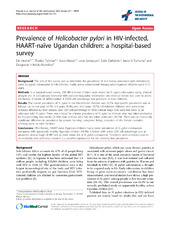| dc.contributor.author | Hestvik, Elin | en_US |
| dc.contributor.author | Tylleskär, Thorkild | en_US |
| dc.contributor.author | Ndeezi, Grace | en_US |
| dc.contributor.author | Grahnquist, Lena | en_US |
| dc.contributor.author | Olafsdottir, Edda | en_US |
| dc.contributor.author | Tumwine, James K. | en_US |
| dc.contributor.author | Kaddu-Mulindwa, Deogratias H. | en_US |
| dc.date.accessioned | 2012-02-06T13:40:27Z | |
| dc.date.available | 2012-02-06T13:40:27Z | |
| dc.date.issued | 2011-06-30 | eng |
| dc.Published | Journal of the International AIDS Society 2011, 14:34 | en |
| dc.identifier.issn | 1758-2652 | |
| dc.identifier.uri | https://hdl.handle.net/1956/5559 | |
| dc.description.abstract | Background: The aim of this survey was to determine the prevalence of and factors associated with Helicobacter pylori (H. pylori) colonization in HIV-infected, highly active antiretroviral therapy-naïve Ugandan children aged 0-12 years. Methods: In a hospital-based survey, 236 HIV-infected children were tested for H. pylori colonization using a faecal antigen test. A standardized interview with socio-demographic information and medical history was used to assess risk factors. A cluster of differentiation 4 (CD4) cell percentage was prevalent in most children. Results: The overall prevalence of H. pylori in the HIV-infected children was 22.5%. Age-specific prevalence was as follows: up to one year, 14.7%; 1-3 years, 30.9%; and 3-12 years, 20.7%. HIV-infected children who were more seriously affected by their disease (low CD4 cell percentage or WHO clinical stage II-IV) were less likely to be colonized with H. pylori. There was a trend for a lower prevalence of H. pylori in children who had taken antibiotics for the preceding two weeks (21.6%) than in those who had not taken antibiotics (35.7%). There was no statistically significant difference in prevalence by gender, housing, congested living, education of the female caretaker, drinking water or toilet facilities. Conclusions: HIV-infected, HAART-naïve Ugandan children had a lower prevalence of H. pylori colonization compared with apparently healthy Ugandan children (44.3%). Children with a low CD4 cell percentage and an advanced clinical stage of HIV had an even lower risk of H. pylori colonization. Treatment with antibiotics due to co-morbidity with infectious diseases is a possible explanation for the relatively low prevalence. | en_US |
| dc.language.iso | eng | eng |
| dc.publisher | BioMed Central | eng |
| dc.relation.ispartof | <a href="http://hdl.handle.net/1956/5732" target="blank">Helicobacter pylori and faecal calprotectin in apparently healthy and HIV-infected Ugandan children</a> | eng |
| dc.rights | Attribution CC BY | eng |
| dc.rights.uri | http://creativecommons.org/licenses/by/2.0/ | eng |
| dc.title | Prevalence of Helicobacter pylori in HIV-infected, HAART-naïve Ugandan children: a hospital-based survey | en_US |
| dc.type | Peer reviewed | |
| dc.type | Journal article | |
| dc.description.version | publishedVersion | en_US |
| dc.rights.holder | Copyright 2011 Hestvik et al; licensee BioMed Central Ltd. | |
| dc.identifier.doi | https://doi.org/10.1186/1758-2652-14-34 | |
| dc.identifier.cristin | 877815 | |
| dc.subject.nsi | VDP::Medical disciplines: 700::Health sciences: 800::Community medicine, Social medicine: 801 | eng |

